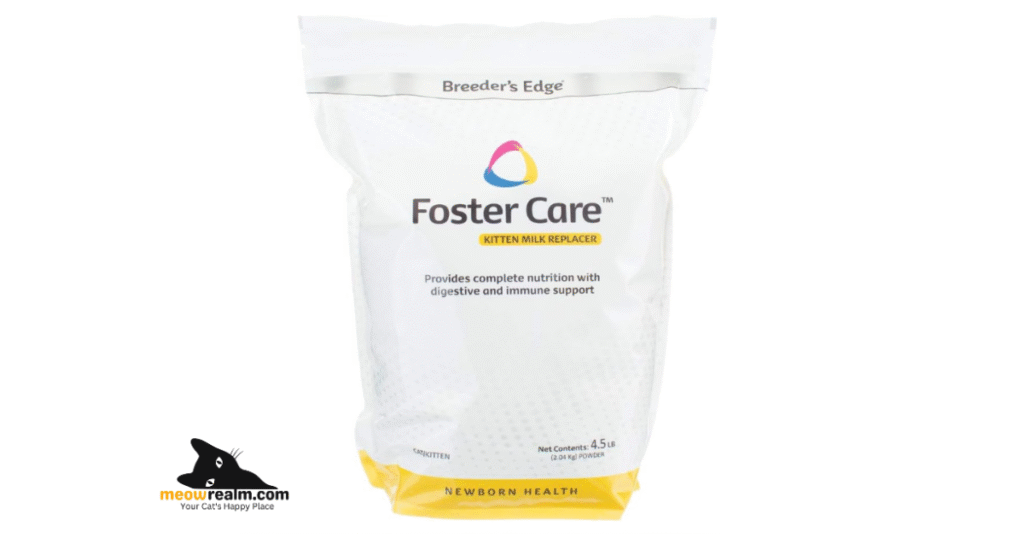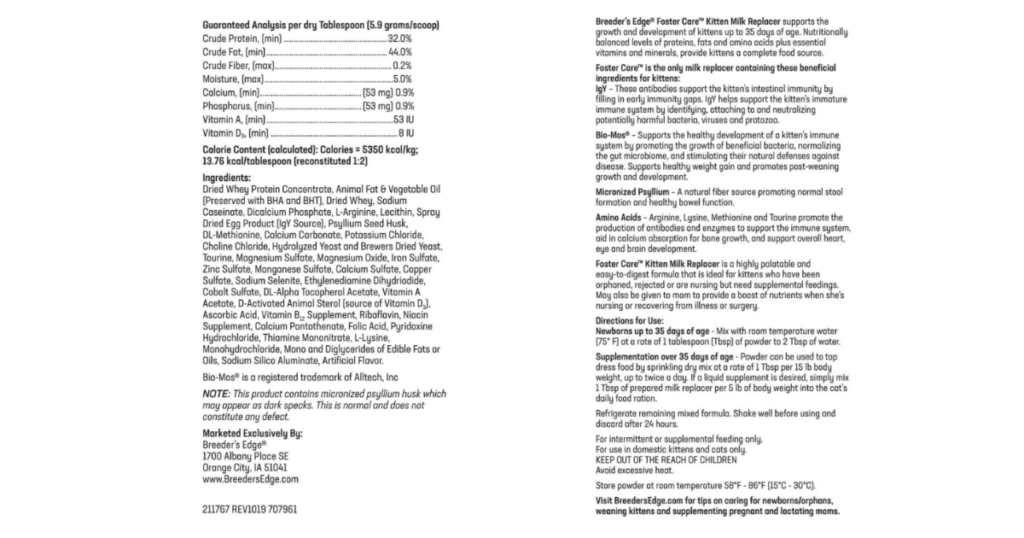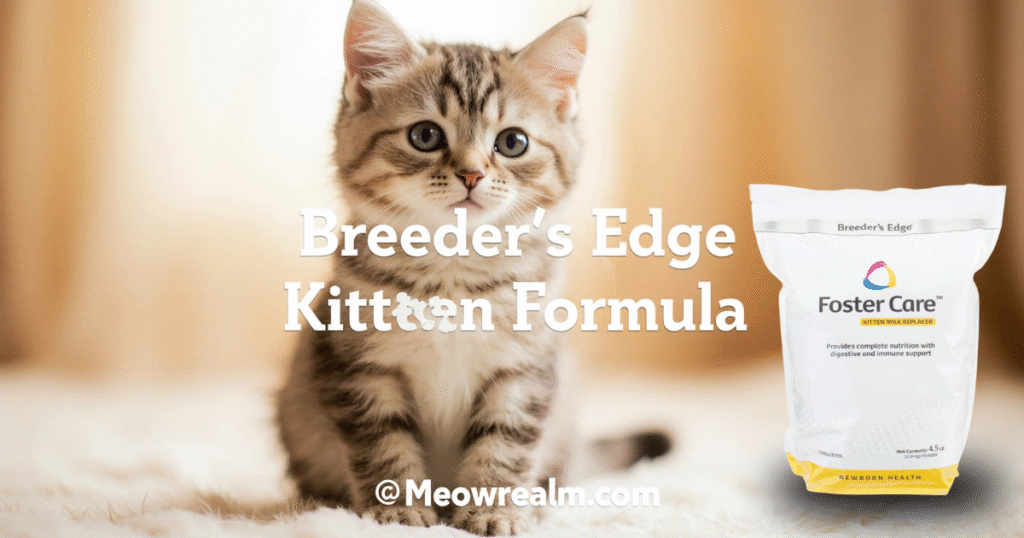Introduction:
Why Breeder’s Edge Kitten Formula Might Be Exactly What You Need
When you’re caring for fragile, just-born kittens—especially orphans—the last thing you want to gamble with is nutrition. Breeder’s Edge Kitten Formula has quietly become a go-to among breeders, rescue fosters, and even overwhelmed pet parents. And it’s not just hype.
Let’s be honest—most kitten milk replacers promise a lot and deliver gas, diarrhea, or worse, dehydration. That’s where Breeder’s Edge breaks the pattern: it’s engineered not just to nourish but to mimic the colostrum and immunity support of a mother cat, with ingredients tuned for actual feline metabolism—not a vague “puppy-and-kitten” blend.
In this guide, we’ll dive deep into what makes it different, how to use it properly (because yes, mixing it wrong will mess things up), what real foster parents are saying about it, and whether it’s worth the slightly higher price tag. Spoiler: if your kitten’s poop matters (and it should), this formula is worth your attention.
Table of Contents
What Is Breeder’s Edge Kitten Formula?

If you’ve ever squinted at a kitten milk replacer label wondering if it’s actually safe—or just a marketing gamble—you’re not alone. Breeder’s Edge Kitten Formula isn’t just another powdered milk. It’s a veterinary-developed supplement specifically crafted for the ultra-fragile digestive systems of neonatal and orphaned kittens.
At its core, this formula mimics the nutritional profile of mother’s milk while sidestepping the lactose-heavy pitfalls of cow-based substitutes. It contains a curated blend of high-quality proteins, amino acids like taurine and lysine, plus probiotics and IgY antibodies to help kittens build immunity from day one. And unlike many competitors, it incorporates Bio-Mos™ and psyllium, which support gut health and ensure more normal stools—a make-or-break detail for bottle-feeding success.
Breeder’s Edge is part of the Revival Animal Health brand family—a trusted name in the breeder and rescue community. Their Foster Care™ Kitten Milk Replacer is the flagship product, but the lineup also includes Kitten Lyte™, a powdered electrolyte blend used to stabilize kittens during times of stress or dehydration.
This isn’t just for orphans either. Many breeders and shelters use it to supplement weak nursing litters, support mama cats with low milk production, or help runt kittens catch up. Because when a few grams of weight gain can mean the difference between thriving and not making it—every drop matters.
Key Ingredients at a Glance
- Whey protein concentrate (high digestibility)
- Taurine, lysine, methionine (feline-essential aminos)
- Bio-Mos™ prebiotics and probiotics (gut flora support)
- Psyllium (for stool normalization)
- IgY antibodies (passive immunity)
- Long-chain fats and fatty acids
FAQ — Is Breeder’s Edge safe for all kittens?
Yes, it’s formulated for newborns up to 6 weeks, and safe for supplementing older kittens or even sick adult cats in recovery. Always follow feeding guidelines based on weight and age to avoid over- or underfeeding.
Why Breeder’s Edge Kitten Formula Stands Out: 4 Key Benefits
You’d think all kitten formulas are more or less the same—but anyone who’s done late-night feedings with a bloated, crying kitten knows better. What sets Breeder’s Edge Kitten Formula apart isn’t flashy packaging or marketing—it’s how reliably it delivers where other formulas fall short: digestion, growth, immunity, and convenience.
1. Digestive Health That Actually Works
Let’s start here, because GI issues are the deal-breaker with most formulas. Breeder’s Edge is low-lactose and contains Bio-Mos™ and psyllium, which support healthy gut flora and promote stool consistency. If you’ve had to clean up post-KMR diarrhea or fight off dehydration from loose stools, this is a game-changer. One Reddit user put it bluntly: “The smell and mess stopped within 24 hours. No more runny poop.”
2. Immune Support Built In
Unlike generic replacers, this formula isn’t just about calories. It includes IgY antibodies that mimic the early passive immunity found in colostrum. That’s crucial for orphans who missed nursing time. Add in amino acids like taurine (essential for feline heart and eye health), and you’re not just feeding—you’re protecting.
3. Balanced, Species-Specific Nutrition
No vague “puppy and kitten” blend here. Breeder’s Edge is calibrated for feline-specific needs, using highly digestible whey proteins and tailored fat ratios to support fast-growing kittens. It meets (and often exceeds) the NRC and AAFCO guidelines for neonatal feline nutrition.
4. No Fridge? No Problem
This formula is shelf-stable and requires no refrigeration until mixed. For foster parents juggling multiple feedings a day (and a fridge full of meds and meat), that’s a major plus. It mixes smoothly (especially in a blender bottle), with fewer clumps than competitors.
FAQ — Does Breeder’s Edge really reduce diarrhea?
Yes, according to numerous breeder and rescue testimonials, kittens fed Breeder’s Edge have more consistent stools and fewer digestive upsets. The inclusion of Bio-Mos™, probiotics, and psyllium is specifically designed to support gut balance and reduce intestinal irritation.

Breeder’s Edge Formula Variants: Which One Does What?
Not all kittens need the same thing at the same time—and Breeder’s Edge seems to get that. Instead of one-size-fits-all, their lineup includes Foster Care™ Milk Replacer for nourishment and Kitten Lyte™ for hydration and recovery. Here’s how they compare and when to use each.
Foster Care™ Kitten Milk Replacer
This is the workhorse product—the main kitten formula most people refer to when they say “Breeder’s Edge.” It comes in multiple sizes (12 oz, 4.5 lb, and 20 lb) and is intended for newborns up to weaning age (about 6 weeks). It contains:
- 42% crude protein (whey-based, highly digestible)
- Essential amino acids: taurine, arginine, lysine, methionine
- Long-chain fats + fatty acids for healthy skin and growth
- Bio-Mos™, probiotics, and psyllium for digestive health
- IgY antibodies to help support a fragile immune system
Mixing ratio: 1 tablespoon of powder to 2 tablespoons of warm water
Storage: Shelf-stable; refrigerate only after mixing
Best for: Orphaned kittens, large litters needing supplementation, underweight newborns
Kitten Lyte™ Electrolyte Supplement
Think of this as Pedialyte for kittens—but with taurine and amino acids cats actually need. Kitten Lyte™ is used during times of dehydration, illness, heat stress, or after surgery.
- Supports fluid balance, electrolyte recovery
- Includes potassium, sodium, taurine, glycine, and citric acid
- Can be used orally or added to the formula if kittens are weak
- Especially useful during GI upset or after bouts of diarrhea
Mixing ratio: 1 part powder to 2 parts water (use warm water)
Flavors: Chicken & pork protein base (feline-friendly)
Best for: Sick, fading, or recovering kittens; hydration support
FAQ — Can I use both products together?
Absolutely. Many foster parents start kittens on Foster Care™ formula and add Kitten Lyte™ into the mix if the kitten is dehydrated or recovering from illness. Just make sure to dilute appropriately and avoid over-concentration.
How to Use Breeder’s Edge Kitten Formula (Without Messing It Up)
Feeding fragile kittens isn’t just about mixing powder and hoping for the best. A misstep in prep, timing, or portioning can mean gas, bloating, or worse—dehydration. Here’s how to get it right with Breeder’s Edge Kitten Formula from day one.
Step-by-Step Preparation Guide
- Use warm water (100–105°F): Not too hot, not cold. Lukewarm is perfect for dissolving without killing nutrients.
- Mix ratio: 1 tablespoon of powder to 2 tablespoons of water. Stir or shake until fully dissolved.
Pro tip: A blender bottle works better than a spoon—fewer clumps, faster mixing. - Let it sit for a minute. If you see foam or air bubbles, gently tap it out or pour carefully to avoid excess air in the bottle.
- Test the temp on your wrist before feeding. It should feel warm, not hot.
- Feed with a sanitized syringe or nursing bottle. Choose the nipple flow size based on the kitten’s age and strength.
Feeding Schedule by Age
| Age (weeks) | Frequency | Amount per feeding |
|---|---|---|
| 0–1 | Every 2–3 hours (day & night) | 2–6 ml (depends on weight) |
| 1–2 | Every 3–4 hours | 5–10 ml |
| 2–3 | Every 4–5 hours | 10–15 ml |
| 3–4 | Every 5–6 hours | 15–20 ml |
| 4–6 | Begin introducing soft food | Reduce formula gradually |
💡 Note: Always weigh kittens daily. A healthy kitten gains about 10–15g per day. If they’re not gaining, reassess formula volume or check for absorption issues.
Mistakes to Avoid
- Don’t use boiling water—it destroys immune-support ingredients like IgY.
- Don’t let mixed formula sit at room temp longer than an hour—bacteria grows fast.
- Don’t skip nighttime feedings the first 3 weeks. Yes, it’s brutal. Yes, it matters.
FAQ — Can I premix and store the formula?
Yes, but only for 24 hours in the fridge. Warm it gently before feeding. Some users freeze individual portions in an ice cube tray and thaw as needed—a smart trick for busy schedules.
What Real Users Say About Breeder’s Edge Kitten Formula
If you’ve spent time in rescue forums, breeder groups, or midnight Reddit rabbit holes (guilty), you’ll find a recurring theme: Breeder’s Edge gets respect because it works—especially when other formulas fail.
Let’s not sugarcoat it. People usually find this product after something goes wrong with a cheaper milk replacer—diarrhea, dehydration, bloating, or slow weight gain. The switch to Breeder’s Edge often feels like a last-ditch move. And then? Relief. Visible improvement. Sometimes overnight.
Rescue and Breeder Testimonials
“The difference in their stool within 24 hours was mind-blowing. I’ll never use KMR again.” — u/SmallCatArmy, Reddit
“I bottle-fed 6 orphaned kittens with it. Not one had diarrhea. That’s a record.” — Volunteer at regional SPCA
“Breeder’s Edge and Shelter’s Choice are the same formula. Both saved our litter after PetAg wrecked their guts.” — Foster parent, r/FosterAnimals
People repeatedly mention:
- No more clumping in bottles (KMR users often complain about powder clots)
- Less gas and vomiting, especially in premature kittens
- Noticeable weight gain within 2–3 days
- Shelf-stable until mixed (huge for busy or rural rescuers)
Negative Feedback? Yes, But Rare
No product is perfect. A handful of users note that:
- The powder can clump if not mixed with warm enough water.
- A batch stored too long (usually from third-party sellers) lost potency or changed color.
- Some kittens disliked the taste compared to other formulas (though this is uncommon).
These issues are often solved by:
- Buying directly from trusted sources (Revival, Chewy, or vet-supplied)
- Using a blender bottle or mini whisk
- Freezing portions to preserve freshness if you’re using it slowly
FAQ — Is Shelter’s Choice really the same as Breeder’s Edge?
Yes—confirmed by users and distributors. Shelter’s Choice is the institutional rebrand of the same formula, often sold to shelters or in bulk. It offers the same protein, probiotics, and antibody benefits.

How Breeder’s Edge Compares to Other Kitten Formulas
If you’ve stood in a pet store aisle staring at PetAg KMR, Esbilac, or a sketchy no-name brand on Amazon, you know the paradox of choice can be paralyzing. So let’s cut through it. Here’s how Breeder’s Edge Kitten Formula stacks up against the two most common alternatives—and why many users say it’s worth the extra few bucks.
PetAg KMR: Familiar Name, Mixed Results
PetAg KMR is everywhere—affordable, easy to find, and often the default recommendation. But the reviews are… complicated.
- Digestive issues are the #1 complaint: diarrhea, gassy tummies, and slow weight gain
- Uses casein (milk protein) which is harder to digest than whey
- No added antibodies or prebiotics, making it less supportive for immune function
- Some users report clumping, even with hot water and whisking
- Comes in powder and canned liquid form
Bottom line: It’s better than nothing, but for fragile or orphaned kittens, many rescue groups switch off it fast.
Homemade Formulas: Unpredictable and Risky
Pinterest and well-meaning blogs are full of DIY kitten milk recipes (egg yolk, condensed milk, yogurt, etc.). But vets consistently warn against these for a reason:
- Unbalanced nutrients can stunt development or cause GI issues
- No taurine = risk of heart or eye problems
- No antibodies, prebiotics, or digestive support
- Inconsistent batches = hard to track health changes
They’re tempting in an emergency, but not viable for long-term use—especially for neonatal kittens.
Why Breeder’s Edge Wins (Most of the Time)
- Whey-based = easier digestion
- Includes Bio-Mos™, taurine, probiotics, psyllium, and IgY antibodies
- Shelf-stable and easy to mix
- Backed by breeders, shelters, and rescue groups
- Offers both nutrition and immune support in one blend
When weighed against real-world outcomes—not just ingredient lists—Breeder’s Edge consistently leads in kitten health, stool quality, and growth rate.
FAQ — Is Breeder’s Edge worth the higher price?
In most cases, yes. While it costs more upfront, fewer vet visits for dehydration or diarrhea often make it more cost-effective long-term. For orphaned or weak kittens, it can genuinely be the difference between survival and failure to thrive.
Where to Buy Breeder’s Edge Kitten Formula (and What to Watch Out For)
So you’ve decided to try Breeder’s Edge Kitten Formula—now the big question: Where can you actually get it, and how much should you expect to pay?
The good news? It’s widely available from reputable sources. The bad news? Not all listings are created equal—and with powdered formulas, freshness really matters.
Most Reliable Sources
- RevivalAnimal.com – Official distributor, full product line, often includes vet-use guides and bundle kits.
- Bonus: Their “Starter Kits” sometimes include syringes and feeding bottles.
- Chewy.com – Trusted by many breeders, fast shipping, good for multi-pet households already ordering supplies.
- Amazon – Convenient but hit-or-miss; only buy from “Sold by Revival Animal Health” or similarly verified sellers.
- Watch for expiration dates and shipping damage.
- Local veterinary clinics – Some clinics stock it or can order for you at a comparable price.
Price Range by Size
| Product Size | Approx. Price (USD) |
|---|---|
| 12 oz canister | $20–$26 |
| 4.5 lb tub | $75–$90 |
| 20 lb bulk | $280–$320 |
| Kitten Lyte (300 g) | $18–$22 |
Tip: The 12 oz size is ideal for first-time users or feeding small litters. The 4.5 lb tub offers better value for large litters or rescues.
Buying Tips from Rescue Veterans
- Check the production/expiration date. Powdered formula does expire. If it’s clumping straight out of the jar or smells sour, return it.
- Avoid warehouse discounters (e.g., eBay, third-party Amazon sellers with low ratings). These often offload old stock.
- Buy ahead of time if you’re fostering or breeding during kitten season—supplies can run low fast.
- Freeze unused powder in airtight bags if you don’t plan to use it all within 3 months. It extends shelf life without degrading nutrients.
FAQ — Can I buy it internationally?
Yes, but check customs regulations. Some countries restrict powdered animal formulas due to agricultural safety laws. Stick with large, pet-specific global retailers if you’re ordering from abroad.
Frequently Asked Questions About Breeder’s Edge Kitten Formula
Does Breeder’s Edge Kitten Formula need to be refrigerated?
Only after it’s mixed. The dry powder is shelf-stable and doesn’t need refrigeration until it’s blended with water. Once mixed, store in the fridge and use within 24 hours.
Can I use Breeder’s Edge for adult cats?
Yes, especially for recovering or underweight adult cats. While designed for kittens, the formula can act as a high-calorie supplement. Some cat parents also use it as a flavor-enhancing topper over dry food.
What’s the shelf life?
Unopened, it lasts about 18–24 months from the manufacture date. Once opened, use it within 3 months for best potency. Store in a cool, dry place and always seal the container tightly.
Why is my formula clumping?
Clumping usually means:
- The water wasn’t warm enough (use 100–105°F)
- You didn’t shake or whisk long enough
- It absorbed moisture due to a poorly sealed container
Solution: Use a blender bottle or mini whisk, and store powder with a desiccant pack if humidity is high.
Is Breeder’s Edge the same as Shelter’s Choice?
Yes. Shelter’s Choice is the non-retail version often sold to shelters or bulk buyers. It’s the exact same formula, with identical ingredients, just branded differently.

